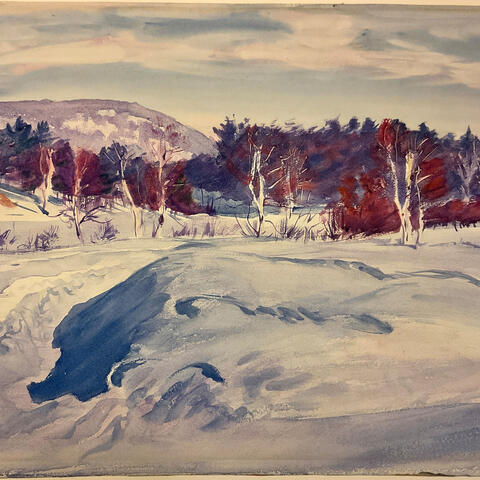Summer by the Charles
Notes From a Writer's Desk

A few hours in a kayak on the Charles is, for me, a uniquely refreshing summer activity. Between instinctual stroke after stroke on the tranquil waters, my mind can relax, thoughts meander, and ideas flow. For calm reflections, I prefer the Charles upstream—near Allston, Waltham, and Newton—where, in summer, one can chance upon blooming lotuses and sunbathing turtles.
Taking in the view from the Charles is just one of many activities that you can do during the summer to reset and recharge your mind. Finding a hobby or even just allowing for some leisure can benefit you both in the short- and long-term, and can be not just a diversion from, but a boost to, your research. Read below for some of our other favorite or newfound summer activities.
–Will Xiao
This summer I bought a foldable camping chair and have been indulging myself by taking it over to the park to work on my writing or knitting. The calm and steady progress from stitch to stitch and row to row makes knitting the ideal form of meditation for me. Just picking up my current project and knitting for five or ten minutes makes me feel more grounded and present. In comparison to the abstract problem-solving required when writing, the problems I encounter when knitting are concrete and technical. If I realize that I made a mistake in the pattern ten rows back, it is frustrating, but the solution is clear—unpick the knitting back to that point and fix the error or live with the mistake. Calculating the number of stitches needed to match the finished dimensions of a sweater activates a different side of my brain than writing.
And yet, as much as I use knitting to clear my head when I feel stuck in the writing process, the two share certain similarities as well. Carrying either a knitting project or writing project through to completion requires imagining what you want to create, collecting materials (yarn or research), creating a plan, constructing the body, troubleshooting issues that arise, and adding the finishing touches. Sometimes recognizing the need to rip out several rows of knitting can give me the courage to let go of a paragraph that is no longer working with the revised argument. At the very least, when I cannot bear the idea of unpicking and knitting the same ten rows for the third time, well, fixing that literature review starts to sound pretty appealing.
–Josephine Reece
“If you, like I, / suffer from writer’s block, I suggest you try / a summer stroll across campus, / the nearest campus you can find— / Granted, I haven’t the power to prescribe, / but that’s what I would try.”
Summer is a great time to take a step back from a strict focus on critical thinking and to flex the creative thinking muscles. This mental exercise, more than a reprieve from the rabbit hole of research, actually translates to better writing (and thinking) in the end. As the opening strophe of my poetic trifle attests, I love to take leisurely walks around campus, picking different routes and allowing the wandering to inspire my imagination. There’s a refreshing serenity in the slow pace of a summer afternoon, when from a shady nook you notice your surroundings in a new light. Indeed, I often carry a notebook and jot down what I see, which on occasion takes a poetic form.
In one case, I indulged a flight of fancy when passing an ivy-covered house, counting “the squirrels and birds / who have made the space their secret abode,” and picturing an inside with “long vines to swing from room to room / anchored by the angular roots of a giant kapok tree in the kitchen / reaching straight up through the roof and on to the sun.” These poems may not tie directly to scholarship, yet the uninhibited flow of thoughts frees my mind from that feeling of being stuck, and activates a side of my brain that allows me to feel the rare joy of a writer’s groove—and the rare pleasure of a summer’s day. You never quite know where such a day will lead, but what a treat it can be to happen upon “that hub of delight on wheels” and “savor the flavors of summer / slowly melting in a sugar-sweet cone.”
–Christopher Brown
As a summer project, I decided to leverage my skills in researching and writing about history to try something new: writing a mystery novel. There is a fascinating resonance between history and mystery. History writing involves meticulous analysis of evidence to reconstruct past events, while crafting a mystery requires piecing together clues, examining motives, and constructing a coherent narrative. I’ve drawn heavily on my historical research skills to inform my fiction, whether delving into archives for authentic details or analyzing character motivations through historical context. The process of uncovering hidden truths and weaving them into a story feels very familiar.
As a historian, I’ve learned to sift through vast amounts of information, identify key patterns, and construct plausible narratives—skills invaluable when plotting a mystery, where the smallest detail can be crucial. Historical analysis has enhanced my ability to create intricate, believable plots by understanding how real events unfolded and the complex interplay of influencing factors. The detective work—if you’ll pardon the pun—involved in both history and mystery writing engages my analytical mind and creative instincts, making the writing process both challenging and rewarding.
This approach enriches my storytelling, making writing an immersive and intellectually stimulating experience. Just as a historian seeks to reveal the truth about the past, a mystery writer uncovers the hidden layers of their narrative—a history of their own creation. This summer, as I immerse myself in my fictional world, I carry the tools and techniques honed through years of historical study, finding joy and inspiration in blending fact and fiction.
–Tony Shannon
Ready to book an appointment with FWC staff? Access the FWC intake form.
Get the Latest Updates
Join Our Newsletter
Subscribe to Colloquy Podcast
Simplecast





